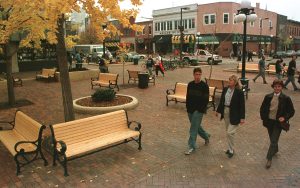Johnson County to use American Rescue Plan Act funds to strengthen food initiatives during COVID-19
Johnson County is looking to increase food accessibility in the community by expanding support of local foods initiatives. The investment is funded through the county’s American Rescue Plan Act funding.
Johnson County Supervisor Candidate Jon Green poses for a portrait on Saturday, May 1, 2021.
March 20, 2022
Johnson County hopes to increase food security for residents by putting money toward local food initiatives that have been negatively affected by COVID-19.
The increase in support for local foods initiatives was one of the projects the county chose to invest in through its American Rescue Plan Act funds.
The project is allocating $200,000 to local food organizations over the next three fiscal years.
Of the $200,000 investment, $50,000 will be used in fiscal year 2022 to support access to local produce and proteins for food-insecure residents.
The Johnson County Board of Supervisors approved initial American Rescue Plan Act investments during a formal meeting last November.
The American Rescue Plan Act is a $1.9 trillion relief package intended to help U.S. communities financially harmed by the COVID-19 pandemic. Johnson County, with a population of roughly 150,000 residents, received $29.3 million.
The $150,000 allocated for the next two fiscal years will support the long-term growth of Johnson County’s community food system. Some of the long-term funding will be used on projects to support better food supply chain infrastructure, bridging the wholesale gap, and access to farmland.
Ilsa DeWald, Johnson County local foods coordinator, said the project’s goal is to create a resilient local food system in times of crisis, as well as reduce barriers for local food and farm businesses to reach consumers.
The pandemic brought attention to the need for investments in Johnson County’s regional food production, DeWald said,as supply chain shortages were occurring in the county and globally.
“It’s been on our radar for a while, and it was really highlighted in the pandemic as some of our larger and longer supply chains were broken at certain points, and the disruptions that those caused,” DeWald said.
DeWald said food insecurity has decreased for Johnson County residents due to federal COVID-19 relief programs, such as the Pandemic EBT and SNAP, ending or returning to their pre-pandemic state.
“We focus a lot on land access to make sure that our producers have access to land at an affordable price that has the infrastructure needed to be able to grow our food crops,” DeWald said.
The long-term investment is needed to assist food producers who had to adapt early in the pandemic to change the way they were distributing their products as restaurants and schools closed, DeWald said.
Food producers in the county met the demand of community-supported agriculture by selling weekly shares of fruits and vegetables to residents, DeWald said, because of supply chain issues early in the pandemic.
“Our producers were able to pivot and make changes in their markets in order to provide for the community,” DeWaldsaid. “We saw that pivot, and what we’re trying to do with these funds is make that more sustainable for the long term.”
Johnson County Supervisor Jon Green said his goal for all American Rescue Plan projects dealing with local food initiatives is that they are environmentally sustainable and a good financial investment for the county.
“[For] local foods, I really hope that we see something that is impactful immediately, but also that is so demonstrative that perhaps its something that the county decides to fund going forward,” Green said.
DeWald said the county has yet to make any decision on which entities to collaborate with on the project, but she is working with local organizations such as the Global Food Project and Field to Family.
She said she is looking to provide recommendations to the supervisors for which organizations the county should collaborate with next month.
Green said he hopes what the county is doing on this project can help inspire other counties across the state to follow suit.
“If you are a produce farmer, it makes a lot of sense if you can sell to a local school district or food hub that can get it out to farmers’ markets,” he said. “We’re doing a lot of good, interesting work here that I hope can be a model for the rest of the state of Iowa.”






